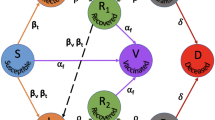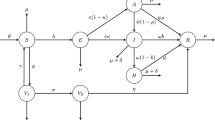Abstract
We analyze a mathematical model of COVID-19 transmission control, which includes the interactions among different groups of the population: vaccinated, susceptible, exposed, infectious, super-spreaders, hospitalized and fatality, based on a system of ordinary differential equations, which describes compartment model of a disease and its treatment. The aim of the model is to predict the development disease under different types of treatment during some fixed time period. We develop a game theoretic approach and a dual dynamic programming method to formulate optimal conditions of the treatment for an administration of a vaccine. Next, we calculate numerically an optimal treatment.




Similar content being viewed by others
Data availability
All data generated or analyzed during this study are included in this published article (and its supplementary information files).
References
Alam, M., Kabir, K.M.A., Tanimoto, J.: Based on mathematical epidemiology and evolutionary game theory, which is more effective: quarantine or isolation policy? J. Stat. Mech. Theory Exp. Online at stacks.iop.org/JSTAT/2020/033502. https://doi.org/10.1088/1742-5468/ab75ea
Bauch, C.T.: Imitation dynamics predict vaccinating behaviour. Proc. R. Soc. B 272, 1669–1675 (2005). https://doi.org/10.1098/rspb.2005.3153
Bauch, C.T., Bhattacharyya, S.: Evolutionary game theory and social learning can determine how vaccine scares unfold. PLoS Comput. Biol. 8(4), e1002452 (2012). https://doi.org/10.1371/journal.pcbi.1002452
Bauch, C.T., Earn, D.J.D.: Vaccination and the theory of games. PNAS 101, 13391–13394 (2004). https://doi.org/10.1073/pnas.0403823101
Britto, C., Foy, B.H., Wahl, B., Mehta, K., Shet, A., Menon, G.I.: Comparing COVID-19 vaccine allocation strategies in India: a mathematical modelling study. Int. J. Infect. Dis. 103, 431–438 (2021)
Faranda, D., Alberti, T., Arutkin, M., Lembo, V., Lucarini, V.: Interrupting vaccination policies can greatly spread SARS-CoV-2 and enhance mortality from COVID-19 disease: the AstraZeneca case for France and Italy. Chaos 31, 041105 (2021). https://doi.org/10.1063/5.0050887
Galewska, E., Nowakowski, A.: A dual dynamic programming for multidimensional elliptic optimal control problems. Numer. Funct. Anal. Optim. 27, 279–289 (2006)
Gumel, A.B., Iboi, E.A., Ngonghala, C.N., Elbasha, E.H.: A primer on using mathematics to understand COVID-19 dynamics: modeling, analysis and simulations. Infect. Dis. Model. 6, 148–168 (2021)
Jentsch, P.C., Anand, M., Bauch, C.T.: Prioritising COVID-19 vaccination in changing social and epidemiological landscapes: a mathematical modelling study. Lancet Infect. Dis. 21, 1097–1106 (2021). https://doi.org/10.1016/S1473-30992100057-8
Kabir, K.M.A., Tanimoto, J.: Evolutionary game theory modelling to represent the behavioural dynamics of economic shutdowns and shield immunity in the COVID-19 pandemic. R. Soc. Open Sci. 7, 201095 (2020). https://doi.org/10.1098/rsos.201095
Machowska, D., Nowakowski, A.: Competition in defensive and offensive advertising strategies in a segmented market. Eur. J. Control 53, 98–108 (2020)
Krishna, M.V.: Mathematical modelling on diffusion and control of COVID-19. Infect. Dis. Model. 5, 588–597 (2020)
Ndaïrou, F., Area, I., Nieto, J.J., Torres, F.M.D.: Mathematical modeling of COVID-19 transmission dynamics with a case study of Wuhan. Chaos Soliton Fractals 135, 109846 (2020)
Nowakowska, I., Nowakowski, A.: A dual dynamic programming for minimax optimal control problems governed by parabolic equation. Optimization 60, 347–363 (2011)
Nowakowski, A.: The dual dynamic programming. Proc. Am. Math. Soc. 116, 1089–1096 (1992)
Nowakowski, A.: Sufficient optimality conditions for Dirichlet boundary control of wave equations SIAM. J. Control Optim. 47, 92–110 (2008)
Pedro, S.A., Ndjomatchoua, F.T., Jentsch, P., Tchuenche, J.M., Anand, M., Bauch, C.T.: Conditions for a second wave of COVID-19 due to interactions between disease dynamics and social processes. Front. Phys. 8, 574514 (2020). https://doi.org/10.3389/fphy.2020.574514
Tanimoto, J.: Fundamentals of Evolutionary Game Theory and its Applications. Springer, Tokyo (2015)
van den Driessche, P., Watmough, J.: Reproduction numbers and sub-threshold endemic equilibria for compartmental models of disease transmission. Math. Biosci. 180, 29–148 (2002)
Wang, H., Yamamoto, N.: Using a partial differential equation with Google Mobility data to predict COVID-19 in Arizona. Math. Biosci. Eng. 17(5), 4891–4904 (2020)
Zeb, A., Alzahrani, E., Erturk, V.S., Zaman, G.: Model, Mathematical, for Coronavirus Disease 2019 (COVID-19) Containing Isolation Class. Hindawi BioMed Research International. Article ID 3452402 (2020). https://doi.org/10.1155/2020/3452402
Zhao, S., Stone, L., Gao, D., Musa, S.S., Chong, M.K.C., He, D., Wang, M.H.: Imitation dynamics in the mitigation of the novel coronavirus disease (COVID-19) outbreak in Wuhan China from 2019 to 2020. Ann. Transl. Med. 8(7), 448 (2020). https://doi.org/10.21037/atm.2020.03.168
Acknowledgements
The authors did not receive support from any organization for the submitted work.
Funding
The authors have not disclosed any funding.
Author information
Authors and Affiliations
Corresponding author
Ethics declarations
Conflict of interest
The authors have not disclosed any conflict of interest.
Supplementary material
In this section, we share for the convenience of our readers complete files created in MATLAB R2015b, which can help realize own calculations. Using files placed at the address http://math.uni.lodz.pl/radmat/article/ the readers can find best strategies, solving system of differential equations (1.1)–(1.8) and solving also (2.1)–(2.2) and (2.7)–(2.8). To check equalities (3.1)–(3.2) in the verification theorem 1, the spreadsheet was used.
Additional information
Publisher's Note
Springer Nature remains neutral with regard to jurisdictional claims in published maps and institutional affiliations.
Rights and permissions
About this article
Cite this article
Matusik, R., Nowakowski, A. Control of COVID-19 transmission dynamics, a game theoretical approach. Nonlinear Dyn 110, 857–877 (2022). https://doi.org/10.1007/s11071-022-07654-6
Received:
Accepted:
Published:
Issue Date:
DOI: https://doi.org/10.1007/s11071-022-07654-6
Keywords
- COVID-19
- Mathematical model of COVID-19
- Game theoretic approach
- Dual dynamic programming
- Sufficient optimality conditions for Nash equilibrium
- Numerical algorithm




